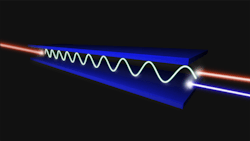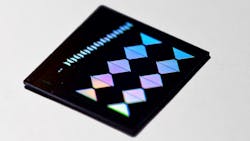Researchers harness SBS effect in a silicon nitride platform
A team of University of Twente researchers (Enschede, Netherlands) created a way to trap sound waves and light on a chip in large-scale circuits. The ability to filter, amplify, and process optical signals is crucial for quantum optics, as well as new telecommunication techniques and sensors.
To build their microwave photonic filter, the team turned to stimulated Brillouin scattering (SBS), which involves using two finely tuned lasers to generate a soundwave with frequencies 1 million times higher than the human hearing threshold and trapping it within a waveguide (see Fig. 1). Light sent through the waveguide interacts with the soundwave, which reflects a very small and specific part of the spectrum and filters the signal.SBS is one of the strongest nonlinear optics effects, and researchers have explored its use in optical fibers for many years—eventually successfully demonstrating high-precision sensors, low-threshold, narrow-linewidth lasers, and narrow-bandwidth filters based on it.
More recently, research interests began to shift toward harnessing SBS in centimeter-length chip-scale photonic devices. “Although experimental demonstrations in various platforms already exist, most SBS devices are still singular and difficult to integrate into large-scale and versatile circuits to fully unleash its potential,” says Professor David Marpaung, who leads the Nonlinear Nanophotonics Group.
Silicon nitride is an emerging low-loss and versatile photonic integration platform, “but previous SBS measurements in silicon nitride waveguides showed a very weak gain coefficient, which makes it difficult to be applied to most applications,” he points out.
His group’s work was inspired by the idea of enhancing the SBS effect in a mature silicon nitride platform without introducing any complicated fabrication steps. “If possible, then we can integrate SBS elements into a large-scale circuit and combine it with emerging technologies such as tunable lasers, frequency combs, and programmable photonic circuits,” Marpaung explains.
Nonlinear optics/SBS
SBS is an interaction between optical and acoustic waves, and “when the light in a waveguide/fiber is strong enough, it causes stress and displacement to the structure,” says Marpaung. “This displacement introduces density variation (an acoustic wave) and a change of refractive index. Further, this index change forms a moving grating and the light gets reflected and downshifted in frequency.”
For an efficient SBS, the optical and acoustic waves must be guided simultaneously. Because the speed of the sound wave in silicon nitride is much greater than in silicon oxide, the acoustic wave always leaked into the substrate in previous demonstrations in silicon nitride.
“We discovered that if we use two layers of silicon nitride instead of one, under certain conditions the acoustic wave is confined in the intermediate layer,” Marpaung says. “In the meantime, the optical wave is also confined around these two layers of silicon nitride. As a result, there’s a large overlap between the optical and acoustic waves—making it possible for efficient SBS in this silicon nitride platform.”
In the group’s most recent work, their breakthrough was successfully harnessing the SBS effect in a versatile and low-loss silicon nitride platform (see Fig. 2).The Brillouin gain coefficient in this platform is high enough for applications in microwave photonics. “By integrating the SBS component with microwave photonics’ functional modules into one circuit, we’re able to build a fully integrated microwave photonic filter with unprecedented performance,” Marpaung says.
And by optimizing the design parameters of the waveguide, “we can further increase the Brillouin gain coefficient in this platform, making it possible to be applied to other SBS-based applications like narrow-linewidth lasers, optical frequency combs, and integrated circulators,” he adds.
Waveguide structures
The team’s platform involves two types of waveguide structures. “One is a symmetric double-stripe (SDS) waveguide, which has a wider gap between the two silicon nitride layers (around 500 nanometers),” says Marpaung. “And the other one is an asymmetric double-stripe (ADS) waveguide with a narrower gap (around 100 nanometers).”
These two waveguides have almost identical optical properties, but to the team’s surprise the SDS waveguide shows a strong SBS response, while the ADS waveguide shows negligible SBS. “We later found out this is largely determined by the distance between these two silicon nitride layers,” Marpaung adds.
One intriguing thing about this feature is that controlling the thickness of the intermediate layer allows them to selectively enhance or suppress the SBS response within a certain part of the circuit.
“Our design’s biggest challenge is the propagation loss of the waveguide,” says Marpaung. “Lower propagation loss means longer effective length, which would ease the requirement on the pump power for a sufficient SBS gain. Lower propagation loss would also reduce the threshold power for an on-chip Brillouin laser in this platform.”
Microwave photonics
One of the most important applications of the team’s work is for microwave photonics.
“It can be used to build a microwave photonic filter with ultranarrow linewidth. It can also be used for tunable laser designs in this platform. Moreover, we can apply the SBS in this platform in the programmable photonic circuits,” Marpaung says.
Next up, the researchers would like to “build a fully integrated microwave photonic system that includes the lasers, detectors, microwave photonic functional modules, and the SBS component in one chip,” says Marpaung. “If successful, it would be the first large-scale SBS microwave photonic circuit to fully unleash the potential of SBS.”
They’d also like to extend the applications beyond microwave photonics by combining the SBS component with other promising technologies such as tunable lasers and frequency combs.
“And we’re looking for other potential scalable photonic integrated platforms that can be applied for SBS,” Marpaung says.
FURTHER READING
R. Botter et al., Sci. Adv., 8 (Oct. 7, 2022); doi:10.1126/sciadv.abq2196.
About the Author
Sally Cole Johnson
Editor in Chief
Sally Cole Johnson, Laser Focus World’s editor in chief, is a science and technology journalist who specializes in physics and semiconductors.



